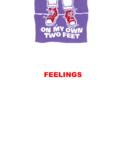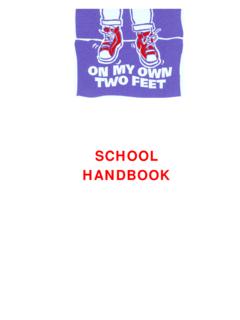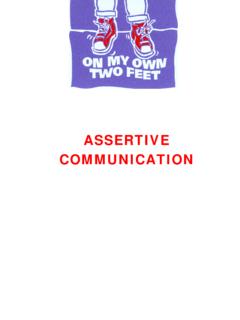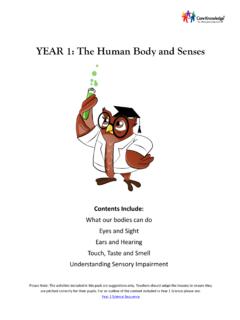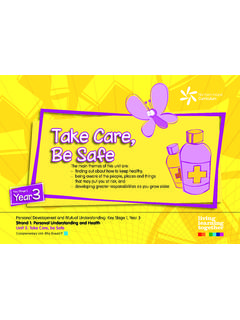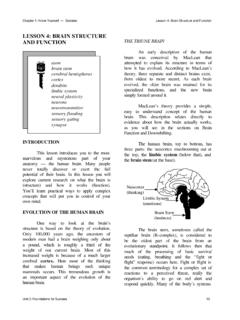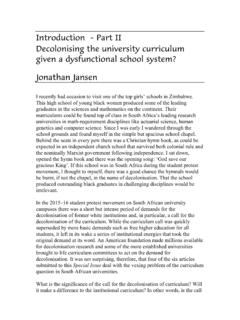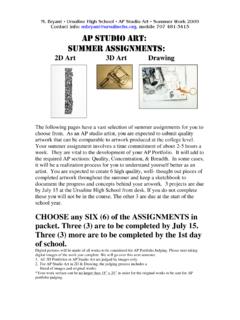Transcription of Social, Personal and Health Education Resource …
1 Social, Personal and Health EducationResource Materials forPost-Primary: Junior CycleSexualityEducationRelationships& Social, Personal and Health EducationResource Materials forSexualityRelationships&AuthorsHelena BrownerElaine Kelly ConroyKaren KeoghFrances RuaneEditor Helena BrownerEducationPost-Primary: Junior Cycle Government of Ireland 1998 Designed by Brian Kelly DesignPrinted by Brunswick Press CycleResource Materials for Relationships and Sexuality EducationForewordThe Resource materials presented here are based on the Interim Curriculum andGuidelines for Relationships and Sexuality Education prepared by the National Councilfor Curriculum and Assessment and approved by the Department of Education andScience. They are not prescriptive, rather they provide a menu of options for classroom lessons from which teachers can choose in accordance with their schoolRSE materials have been prepared by experienced teachers under the guidance of theRSE Training Support Service for Schools.
2 They have been evaluated by personnel fromthe Department of Education and Science, the RSE Training Support Service forSchools and classroom teachers in the Pre-Test Schools. The NCCA has been consultedin the development of these materials and has deemed them to be compatible withthe Interim Curriculum and is the responsibility of those who are drawing on these resources to satisfy themselves that the content of materials which they use is appropriate to the needsof students and in line with their school RSE Policy and sincere word of gratitude is due to all who contributed to the development andcompilation of these Resource materials. Undoubtedly they will be of immense help toall who are involved in the social, Personal and Health Education of young CycleResource Materials for Relationships and Sexuality EducationAcknowledgementsThe development of these materials has been co-ordinated by the RSE TrainingSupport Service for Schools.
3 This service, with responsibility for supporting the implementation of RSE in primary and post-primary schools nationally, was set up atDrumcondra Education Centre in October 1995. The RSE Training Support Service forSchools is funded by the In-Career Development Unit, Department of Education andScience and the European Social Department of Education and Science is grateful to the many people who havecontributed to the production of this Teachers Handbook. Their commitment andinvaluable assistance throughout the project has resulted in the successful completionof the materials. Thanks are extended to:4 Junior CycleResource Materials for Relationships and Sexuality EducationThe RSE Training Support Service for SchoolsNora Brennan, Training Co-ordinatorAine Lawlor, Assistant Co-ordinatorJocelyn Kelly, Secretary The AuthorsHelena Browner, Author and EditorElaine Kelly Conroy, AuthorKaren Keogh, AuthorFrances Ruane, AuthorThe RSE Implementation GroupChair: Emer Egan, Senior Inspector, In-CareerDevelopment UnitThe RSE Project Management GroupChair.
4 Paul Doyle, Principal Officer, In-CareerDevelopment UnitPre-Test SchoolsThe Pre-Test Post-Primary Schools, co-ordinatedby Siobhan TrainersThe National TeamStaff at the Department of Education andScienceFeargas O Casaide, Psychological ServiceAustin Vaughan, Psychological ServiceFionnuala Ui Chathasaigh, Cigire SinsearachMaire Ni Luain, CigireThe NCCA Post-Primary Working GroupAnne Looney, NCCAJohn Lahiff, Health Promoting School ProjectBrian McAuley, Post-Primary School PrincipalSr. Pat Murray, NCCAThe Council Members of the NCCAM edical AdvisorDr. Therese Wilson, South Eastern Health BoardThe Drumcondra Education CentrePatrick B. Diggins, Director, and StaffEducation Centre NetworkThe Department of Education and Science wouldalso like to thank the following for permissionto use copyright material :Poverty in Focus, A Transition Year Supplementto Fair Shares ? ,Combat Poverty Agency and ASTI, 1995 Boston Women s Health Book Bodies, Ourselves, for the New CenturyNew York,: Simon and Schuster, 1998 ContentsIntroduction 6 Lesson No.
5 TitlePage 1 The Circle of Life172 Communication and Respect293 Feelings and Adolescence374 Saying How I Feel475 Body Awareness-Body Care556 Hygiene Hints!617 Common Senses678 The Image of Me759 The Words we Use8310 Puberty8911 Human Reproduction9912 The Miracle of New Life11313 Pregnancy and Birth12314 How I Relate13515 Family Ties14116 You ve Got a Friend15517 Boy/Girl Relationships16318 Don t Box Me In!17319 Self-Esteem18520 Peer Pressure19121 Take Care!19922 Time to Reflect21123 Teenage Pregnancy21924 Respect and Tolerance for Difference229 References2355 Junior CycleResource Materials for Relationships and Sexuality EducationIntroductionBackgroundRelations hips and Sexuality are key elements of healthy social and Personal development in all our lives, but particularly in the life of an adolescent. Adolescenceis marked by the onset of physical sexual maturity. This stage of development is alsomarked by the establishment of first significant boyfriend/girlfriend relationships, bythe first experience of sexual attraction and by the experience of falling in, and out,of love.
6 There is greater freedom and responsibility and exposure to a bewilderingvariety of messages about sexuality, issues of sexual orientation and the place of sexuality in Personal and social life. Sexual development calls for the critical evaluation of the wide range of information, opinions, attitudes and values withwhich adolescents are on the work done in primary school, Relationships and Sexuality Education (RSE) at post-primary level seeks to provide opportunities for young people to learnabout relationships and sexuality in ways that will enable them to think and act in amoral, caring and responsible Aims and ObjectivesAimslto help young people understand and develop friendships and relationshipslto promote an understanding of sexualitylto promote a positive attitude to one s own sexuality and in one s relationship withotherslto promote knowledge of and respect for reproductionlto enable young people to develop attitudes and values towards their sexuality in amoral, spiritual and social should enable the students to.
7 Lacquire the understanding and skills necessary to form healthy friendships and relationshipsldevelop a positive sense of self-awareness, and the skills for building and maintaining self-esteemlbecome aware of the variety of ways in which individuals grow and change especially during adolescence and to develop respect for difference between individualslunderstand human physiology with particular reference to the reproductive cycle, human fertility and sexually transmitted infectionslunderstand sexual development and identity and explore aspects of sexuality including sex role stereotyping, gender issues and cultural influences on sexualitylvalue family life and appreciate the responsibilities of parenthoodldevelop strategies for decisions and actions consistent with Personal moral integrity and respectful of the rights and dignity of othersldevelop skills for coping with peer pressure, conflict and threats to Personal CycleResource Materials for Relationships and Sexuality EducationSSoommee ooff tthheessee oobbjjeeccttiivveess wwiillll bbee ssuuppppoorrtteedd bbyy ootthheerr eelleemmeennttss ooff SSoocciiaall,, PPeerrssoonnaall aannddHHeeaalltthh EEdduuccaattiioonn ((SSPPHHEE)),, bbyy tthhee bbrrooaaddeerr ccuurrrriiccuulluumm aanndd tthhee wwhhoollee sscchhooooll (Relationships and Sexuality Education , Interim Curriculum and Guidelines for post-primary schools, page 10)The Purpose of these RSE Resource MaterialsThese resources were compiled with a view to providing teachers with a range ofmethodologies and a variety of resources which they can use in implementing an RSEprogramme in schools.
8 These resources have been drawn together using the threethemes set out in the Interim Curriculum and Guidelines: human growth and develop-ment; human sexuality; and human relationships. How these resources are used willdepend on:lthe school policy on RSE as drawn up by the staff, principal, parents, board of management;lexisting provision for RSE in the school;lthe RSE needs within the school, given the school s cultural context;lthe ongoing evaluation of the strengths and weaknesses of the school s RSE Relationship between the Teacher and the StudentsIn organising the learning environment, the teacher will be careful to create anatmosphere which respects the privacy of each individual student and treats all students with due sensitivity and care. Some important considerations might be:lthe degree of trust, respect and positive regard for students;lthe relationships between the teacher and the students and among the students themselves;lthe need for clear expectations, goals and learning is important that ground rules and codes of behaviour should be discussed andagreed with the class.
9 It is, therefore, within this context that the teacher would provide a stimulating and supportive environment. Doing this will also facilitate andenhance effective teaching and learning in the class group. Some suggestions for setting ground rules in general, and in particular for group discussions, are set out onpages 11 and 12 of this introduction. Along with setting ground rules, it might also beuseful to establish good communication and listening skills among the student bodybefore using these RSE resources (see Lesson 2: Communication and Respect).The Role of the TeacherA key factor in the role of the teacher in RSE is the facilitation of experiential learning. Teacher-talk , although at times necessary, should be kept to a training in RSE or other aspects of SPHE is essential for the effective andappropriate use of these resources. Throughout the resources, topic notes and background information for teachers have been provided.
10 It is intended that thisinformation be used as briefing notes for teachers, and is therefore not intended to be7 Junior CycleResource Materials for Relationships and Sexuality Educationpassed on directly to the students. Wherever possible, participatory methods are suggested so that students can creatively interact with material , thus learning is ultimately more real and relevant to the students present and future Moral ContextThe Interim Curriculum and Guidelines make it clear that the values in an RSE programme should be consistent with the core values and ethos of the school ( ) Resource materials chosen in support of a school s RSE programme should also reflectthese Resource materials were prepared in the light of the following value statements:levery individual is unique and valued in his/her own right;lwe are all sexual beings from womb to tomb;lmaking decisions about sexual behaviour is not simply a private and Personal matter - there are also social and community implications;lsexual intercourse is an expression of intimacy and relationship - it is not appropriate to casual encounters.
